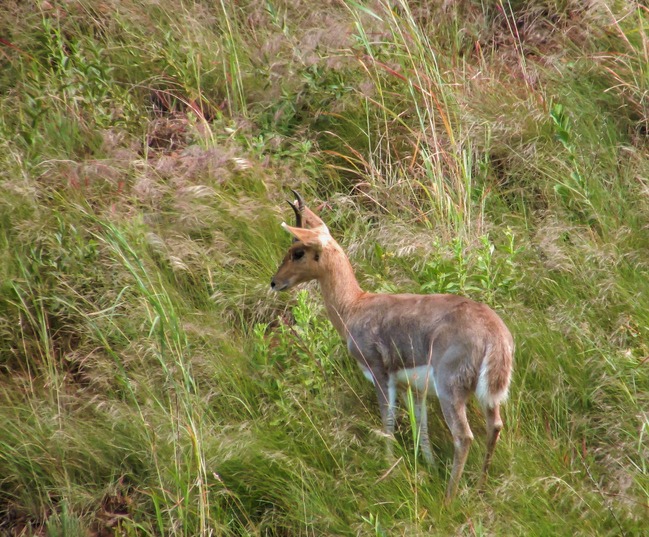They may seem average due to their medium size, but they are quick runners that can run up to 59 km/hr, have sharp eyesight, and are excellent jumpers. They are Grey Rheboks, a species of antelope that is native in the African continent.
Read further to know more about the Grey Rhebok.
What is a Grey Rhebok?
The Grey Rhebok, or also known as the Grey Rhebuck, is an antelope species that commonly resides in African countries such as South Africa, Lesotho, Eswatini, and Zimbabwe. With the binomial name of Pelea Capreolus, the Latin meaning of the latter word speaks much of how it looks: “little goat.” They are confined in grassy, montane habitats such as sourveld, which is generally 1000 meters above sea level. However, some of its kind were sighted in the coastal belt of the Cape.
The members of its species are widespread, but several of its locations remain unknown up to this day.
Its seven levels of classification are as follows:
Kingdom: Animalia
Phylum: Chordata
Class: Mammalia
Order: Artiodactyla
Family: Bovidae
Genus: Pelea
Species: Pelea cepreolus
This species is listed as “Near Threatened” by the International Union for Conservation of Nature (IUCN), with its current population trend continuously declining. Its population is estimated to be 2,000 individuals in formally protected areas. It is believed that there are still 18,000 individuals in unprotected areas.
Grey Rhebok Description
The Grey Rhebok is often mistaken as a Mountain Reedbuck (or also known as Redunca fulvorufula), an antelope prevalent in the mountains of sub-Saharan Africa because of its physical attributes. However, one visible sign that can help you distinguish a Grey Rhebok from a Mountain Reedbuck are their horns. The latter’s horns are curved forward, forming a “V.” Meanwhile, the Grey Rhebok’s horns are narrow and parallel.
The Grey Rhebok is medium in size that weighs an average of 19-30 kg (42-66 lb) and grows an average of 70-80cm. Male Grey Rheboks are a bit larger than the female ones, and the males are the only ones who have sharp and straight horns standing for about 15-25 cm long from their heads.
Grey Rheboks are dominantly pale gray in color, except its underbelly and some parts of their legs and faces, which are white in color. They have slender ears and long neck. Their furs are short and dense that gives them protection during the cold seasons.
Grey Rhebok Habitat, Ecology, and Distribution
Grey Rheboks are mainly found in grasslands and scrub savanna regions, which are situated in high mountains and slopes in the Drakensberg Mountain range. During the rainy season, the period from September to March, they move to higher hills. When the dry season arrives, they move to lower grassland slopes. A Grey Rhebok is also known to be “water independent,” meaning, they do not need a stable source of water to survive because they get enough moisture and hydration from browsing.
Some Interesting Facts About the Grey Rhebok
Grey Rheboks are both grazers (animals who rely on grass for sustenance) and browsers (animals who are dependent on leaves for sustenance) in nature. They are polygynous—they group themselves into herds, which commonly consists of 1 male Grey Rhebok, several female Grey Rheboks, and their calves. Mating takes place between January and April. A female Grey Rhebok goes through a gestation period for seven months and then gives birth to a single calf during late summer and spring.
They are territorial and social animals. Male Grey Rheboks mark their territories by defecating and urinating in their preferred areas. Together with their calves, the female Grey Rheboks stay with their male partner in his marked territory.
Researchers Skinner J.D. and Chimimba C.T. (2005) also deemed Grey Rheboks to be “accomplished leapers” because they can jump over fences successfully. They are generally more active when the sun is up, and they rest in the afternoon when it gets scorching hot. They are also famed for their heightened sense of sight due to their ability to see things that are more than 200-400 meters away.
When there is a threat, a Grey Rhebok snorts, stomps, and runs away when the threat is too dangerous. Sometimes, when a male Grey Rhebok gets aggressive, it fights the threat to protect its female partners and calves.
WILDLIFE PARKS AND RESERVES WHERE THIS SPECIES IS FOUND:
SOUTH AFRICA
• Addo Elephant National Park
• Cape Peninsula National Park
• Hluhluwe Game Reserves
• Knysna Lagoon
• Kruger National Park
• Madikwe National Park
